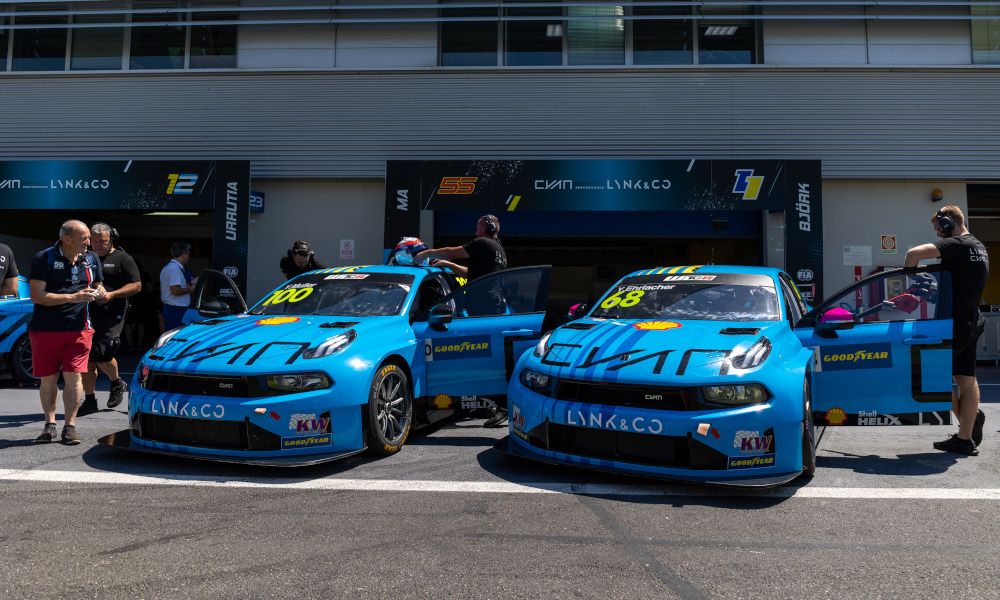Cyan Racing sensationally withdrew from the FIA World Touring Car Cup last week, part-way through the season, in a row over tyre issues and Balance of Performance [BoP] measures.
The statement issued by the Swedish team ahead of last weekend’s WTCR event at Anneau du Rhin sent shockwaves through the top level of the sport.
However, the drastic action taken by the team needn’t have been handled in the way it was. Even at the previous round at Vallelunga, the timing of decisions was questionable – the team only sent out its formal statement announcing it would not race as the cars were forming up on the grid.
There is no doubt that there have been tyre issues in WTCR this year. But were those issues as unworkable as Cyan Racing have suggested? And have the issues of BoP and tyre failures been conflated to try to leverage the situation?
To understand the situation better, TouringCars.Net has taken a look at some of the statistics surrounding the Lynk & Co 03 TCR car’s successes – and how it fares in terms of lap time performance with its rivals.
The facts – BoP measures
Since its introduction at the start of 2019, the Lynk & Co 03 has been one of the most heavily ‘penalised’ TCR cars, consistently featuring at the upper end of the BoP scales.
Ahead of the opening round of the 2019 WTCR, the car was given BoP measures of 30 kg additional weight and a reduced engine power output of 97.5% – the latter being something it has had to live with ever since.
As of 26 July 2022, the only other cars running with 97.5% power are the Hyundai i30 N and the Hyundai Veloster N – but Cyan Racing doesn’t see engine power as the cause of their concern.
Cyan Racing is concerned about weight, with the car’s BoP weight sitting at 50 kg since August 2021, after it was reduced from 60 kg where it had been for the previous year.
At present, no cars run with 60 kg of weight, but the only other car running at 50 kg is the Hyundai Veloster N – which is notably a smaller car and also runs with the highest ride-height of any TCR car, whilst not being a direct rival for Lynk & Co – the two cars have never competed in the same series together.
Of the Lynk & Co’s direct rivals in WTCR, the Hyundai Elantra has to carry 10 kg of BoP weight, whilst the Honda bears 20 kg of BoP weight. Neither the CUPRA nor the new Audi have any BoP weight –the Audi has been free of BoP weight since October last year and the CUPRA since July 2021.
So, from a tyre safety point of view, the Lynk & Co is undoubtedly the heaviest car in WTCR. Including Compensation Weight, it runs at 1,355 kg and its next nearest rival is currently the Honda Civic at 1,305 kg. But it’s worth noting that the Honda has previously run at 1,345 kg for the Aragón, Hungaroring and Most races in 2021, whilst the Hyundai Elantra also ran at 1,335 kg at Most, Adria and Sochi in 2021.
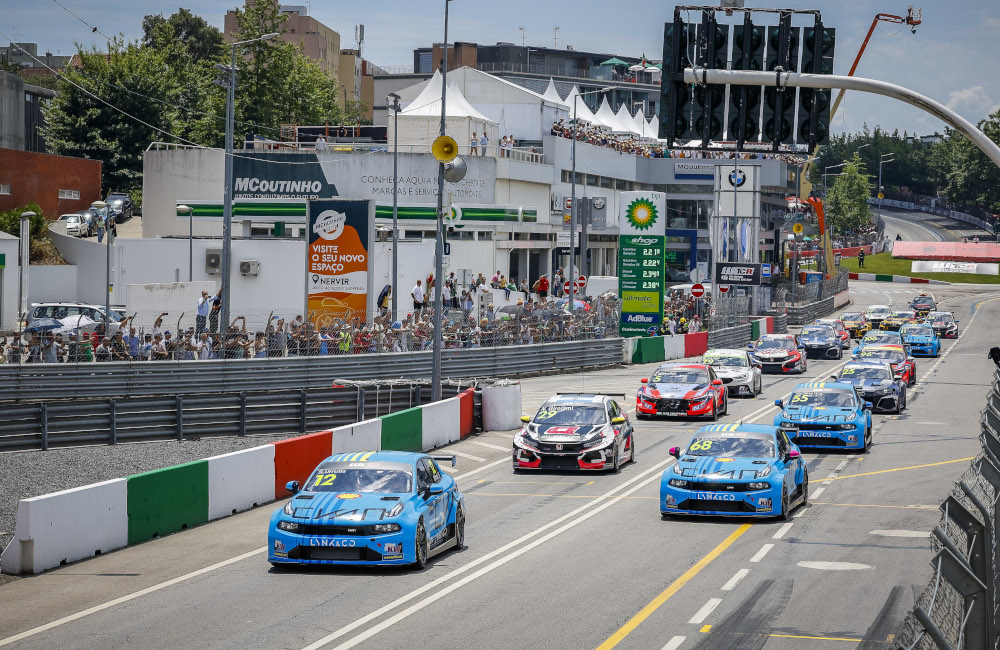
Ahead of last weekend’s round at Anneau du Rhin, all WTCR competitors were offered a 20 kg weight break in order to alleviate the tyre concerns – this would have taken the Lynk & Co 03 down to 1,335 kg had they chosen to race.
The FIA stated that “following tyre issues at the previous event, the appointed WTCR tyre supplier (Goodyear) has identified the high weight of cars as a key factor.
“Therefore, in the interest of both safety and sporting equity, the TC Committee takes the decision to reduce the minimum racing weight of all models raced in WTCR.
“This decision is taken only in relation to WTCR and does not affect any other competition featuring TCR spec cars.”
Thus, the Lynk & Co would have been running at a weight which the Honda cars had run above for three WTCR events in 2021, and at the same weight as that which the Hyundai Elantra N ran at for three other events in 2021.
So, whilst it is true that the Lynk & Co 03 is the heaviest car in WTCR, it was offered the chance to run at a weight previously run at by other manufacturers last year.
As well as BoP weight, of course there is Compensation Weight, which is specific to WTCR and which saw its maximum reduced from 60 kg to 40 kg for 2022. On the Compensation Weight front, the Lynk & Co 03 is comfortably heaviest.
For the first three events of 2022, the Lynk & Co carried no additional Compensation Weight (which, aside from Honda in the third round, was the same for every manufacturer).
Prior to the fourth round at Aragón, 10 kg was added. This was increased to 20 kg for Vila Real, and then to 40 kg prior to Vallelunga, the latter taking the car’s total weight (BoP and Compensation Weight) to 1,355 kg.
Factoring in both BoP and Compensation Weight, the next heaviest car is the Honda Civic, at a total of 1,305 kg.
The Compensation Weight calculation, being a sporting regulation rather than a technical one, is published and entrants have signed up to compete that basis. Thus, the only interpretation is that Cyan Racing is unhappy with its BoP weight of 50 kg, which is 30 kg more than the next WTCR car.
It is perhaps understandable how Cyan Racing feels frustrated at this situation. When tyre failures are a concern, engineers will work to change the setup of a car to reduce the risk, often at the sacrifice of performance.
But with a heavier car to work with in the first place, the options available in the metaphorical toolbox of Cyan’s engineers are already more limited due to the higher starting weight as a result of both BoP and Compensation Weight.
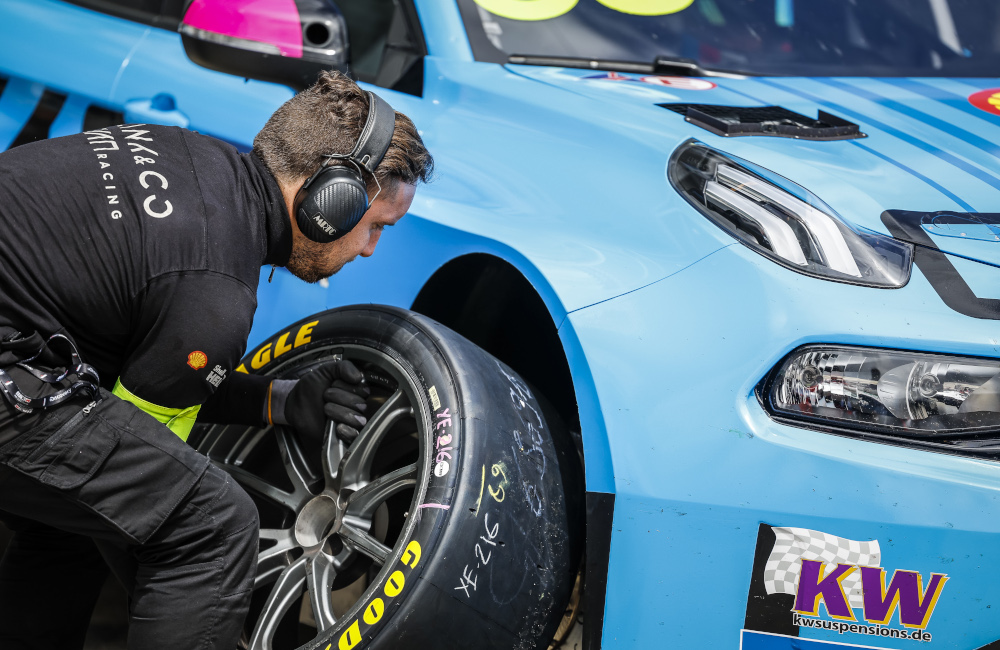
View from a rival
TouringCars.Net asked Comtoyou Racing’s Team Principal Jean-Michel Baert for his take on the situation.
“[Tyre] problems due to overloading the tyre exist in all categories,” said Baert. “Look at the Pirelli tires at the 1000 km of Le Castellet or at the 24h of Spa… and there, the teams don’t quit during the season or put pressure on SRO to cancel the race. They know they’re asking a lot from the tyres!
“It’s true that they [Cyan] won the previous championships without encountering any problems, with roughly the same weight, or even heavier.
“This year, the other brands have worked hard to get back up, so the task is more difficult for them.”
Baert questioned why Cyan Racing was calling for a further 30 kg reduction in weight when several other changes had been implemented in order to quell the Swedish team’s concerns.
“It is very difficult to judge car performance by what you see on TV or even on location. During qualifying, the teams manage the time achieved to avoid gaining Compensation Weight [CW], so it’s not because you’re only fifth that your car isn’t the most efficient.
“Suddenly during the races, you are by far the most efficient. The BoP + CW system is certainly to be reviewed to ensure the show!
“The BoP will always be a topic of discussion. Several brands have won or have made poles, we can say that none dominates the championship. That’s what we want, right?
“The FIA and WSC proposed to all teams to lower the weight of all cars by 20 kg, to implement an FP0 and to make changes to the carry-over tyres regulation.
“This was done at the request of Lynk & Co … Why did they want another 30 kg lighter only on their cars?”
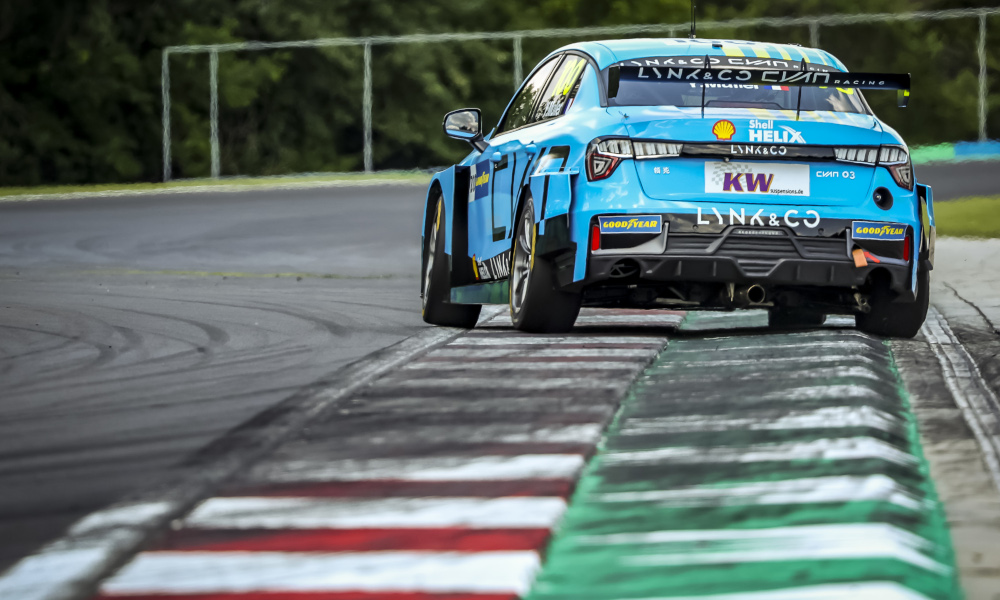
Opinion: Cyan Racing’s performance
As one of the top teams in WTCR, Cyan Racing employs a formidable driver line-up. There is two-time champion Yann Ehrlacher – the reigning champion – along with his uncle Yvan Muller, a four-time World Touring Car champion and one of the most successful drivers in the sport’s history.
Not forgetting Thed Björk, the 2017 World Champion and a multiple title winner in Scandinavia, whilst new and young talent is represented by Santiago Urrutia, yet to win a touring car title but a five-time race winner already in WTCR.
And of course, the team has won every title it has been eligible for since 2019, with the exception of that year’s drivers’ crown.
Success has not been scarce. The Lynk & Co 03 is second only to the Honda Civic in terms of most poles – and both cars have entered the same number of sessions. No car has won more WTCR races or scored more WTCR podium finishes than the Lynk & Co 03.
In statistics, it’s never as simple as taking absolutes – so to better understand these numbers, they need to be normalised. If we do that, then the Lynk & Co 03 still fares well – second in terms of its poles to sessions ratio, and still on top in terms of its race wins and podiums scored ratios.
One area in which the Lynk & Co 03 isn’t on top is lap times. Perhaps this is a better measure of performance.
To analyse this, we have taken the fastest qualifying lap for each model of car in a session, and the fastest race lap for each model of car in a race.
These times are then processed into a percentage of the overall fastest lap for any car in that session. By then averaging this over all sessions for each model of car, we can come up with a single percentage to assess which car is, in general, producing the fastest laps in both qualifying and race.
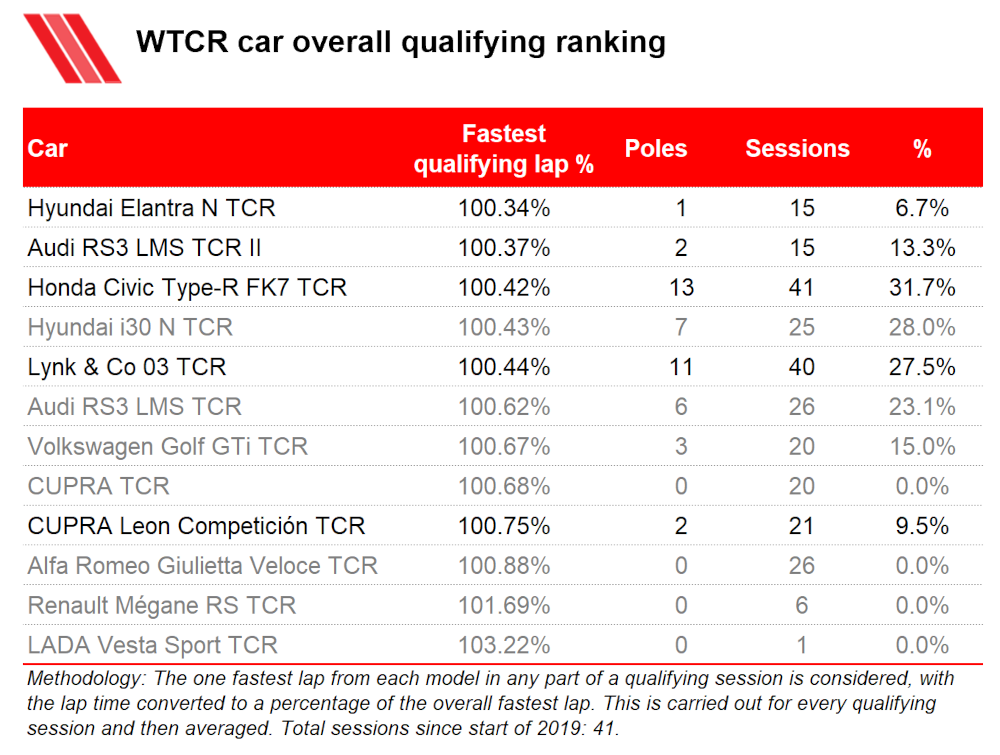
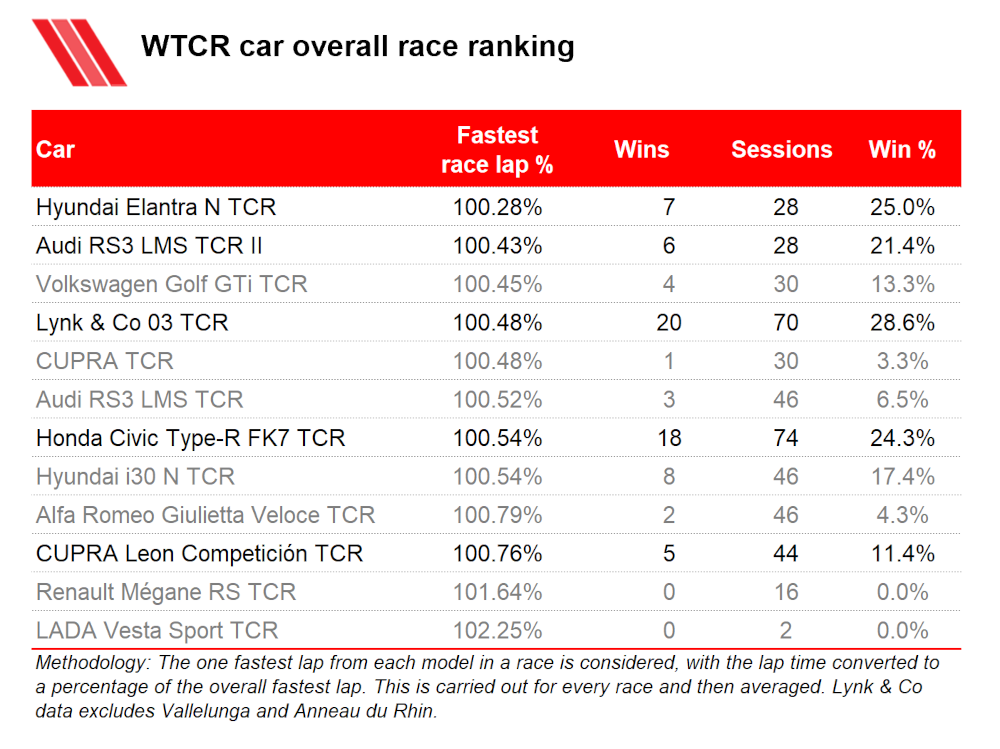
What this shows is that the newer cars come out on top – the Audi RS3 LMS II and the Hyundai Elantra N for qualifying laps and the Hyundai Elantra N for race laps.
With the Lynk & Co 03 ranking fourth in average qualifying lap pace and third in average race lap pace, it appears to not be the fastest car in the WTCR field.
But the car continues to be hit with the most punitive BoP measures in the WTCR field. If you look at the list of champions in the WTCR from 2019 to 2021, at first glance you might find it hard to justify calling for change.
Of course, TCR employs a Balance of Performance formula, not a balance of results, so the best car – team – driver combination should still emerge on top.
But performance and results are linked, so it still remains a useful metric upon which to assess the situation.
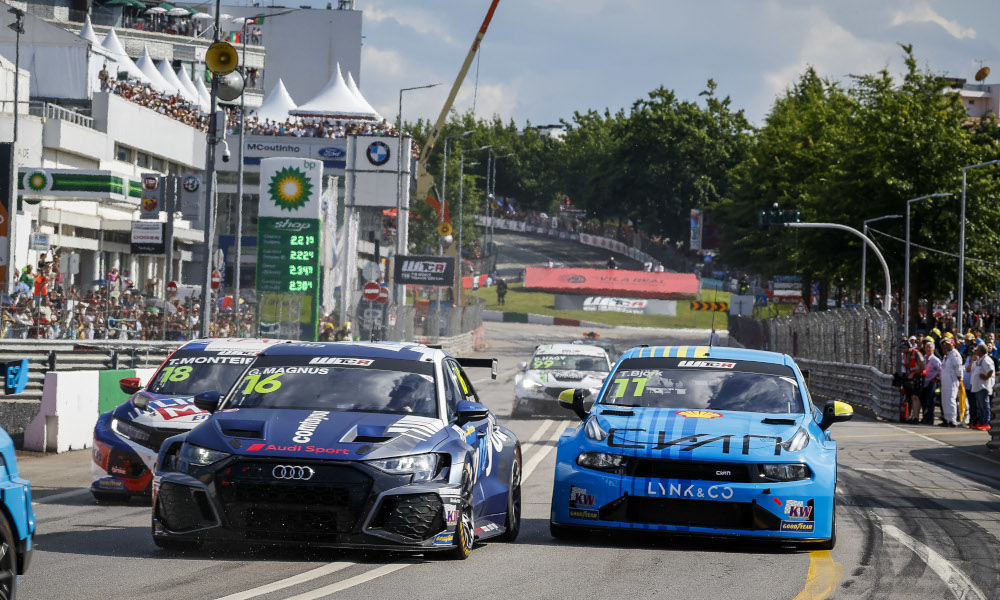
Another way to look at it is that the two cars with the most pace are the new Audi RS3 LMS TCR II and the Hyundai Elantra N TCR. Both have shown strong single-lap pace since their introduction at the start of 2021.
The game is starting to shift in WTCR with newer cars and if defending champions Cyan Racing feels that it needs to up its game, with the oldest car in the field, but cannot do so because of restrictive weight measures and the looming threat of tyre failures, it’s understandable that it may feel its options are limited.
A Cyan Racing spokesperson previously told Autosport that it felt that BoP is no longer necessary in WTCR. Changing the rules to take BoP out in the middle of the season would be unfair to other competitors.
Making BoP adjustments in tight timescales, as WSC President Marcello Lotti recently revealed, would also be unfair to other competitors.
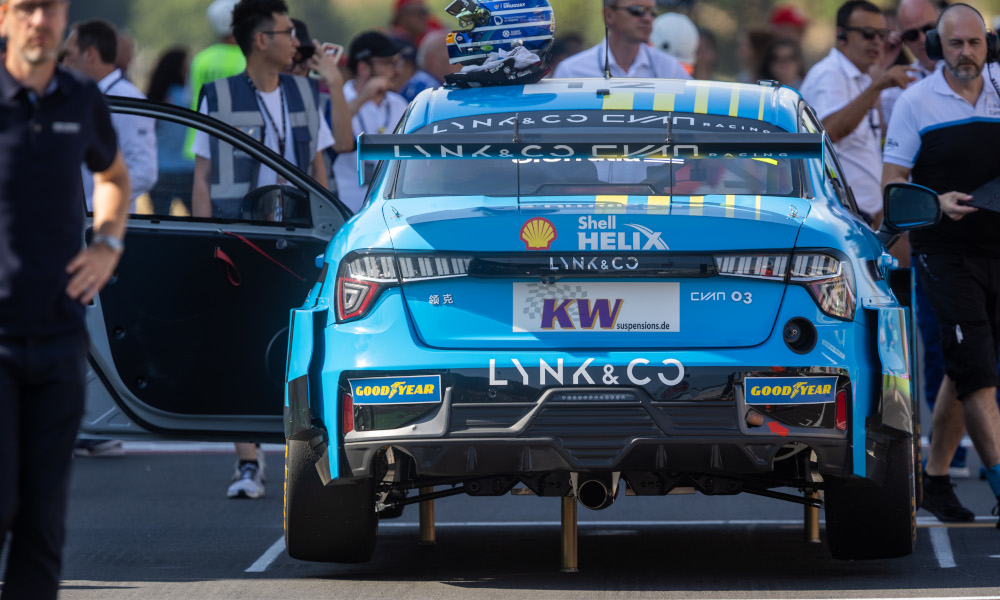
Consequently, Cyan Racing has chosen not to continue, in a way which is both damaging for the championship and also TCR racing in general.
Touring car racing has always been political – often to the detriment of the sport – as manufacturers put their interests first.
But the way in which a tyre issue has been conflated with a Balance of Performance weight issue, at a time when the sport needs its stakeholders to come together for the good of the series, is extremely damaging for both Cyan Racing, TCR and WTCR.
Comtoyou Racing’s Baert agrees. “This situation is not pleasant and not good for the series,” said Baert.
“We must all be together with all the other brands to show that touring cars has its place and must once again become a great competition! Let’s continue with those who want [to race]!”
Even the way in which Cyan Racing withdrew its cars at Vallelunga – at the very last minute at the end of the formation lap, with a pre-prepared statement issued within seconds of the cars entering the pitlane – was designed for maximum impact rather than respect of the other stakeholders.
With Cyan Racing hitherto supplying almost a third of the field in 2022, perhaps it felt it had ‘strength in numbers’ to provoke action in its favour.
Instead, it has left the series at an even lower point and done its own reputation no favours.

